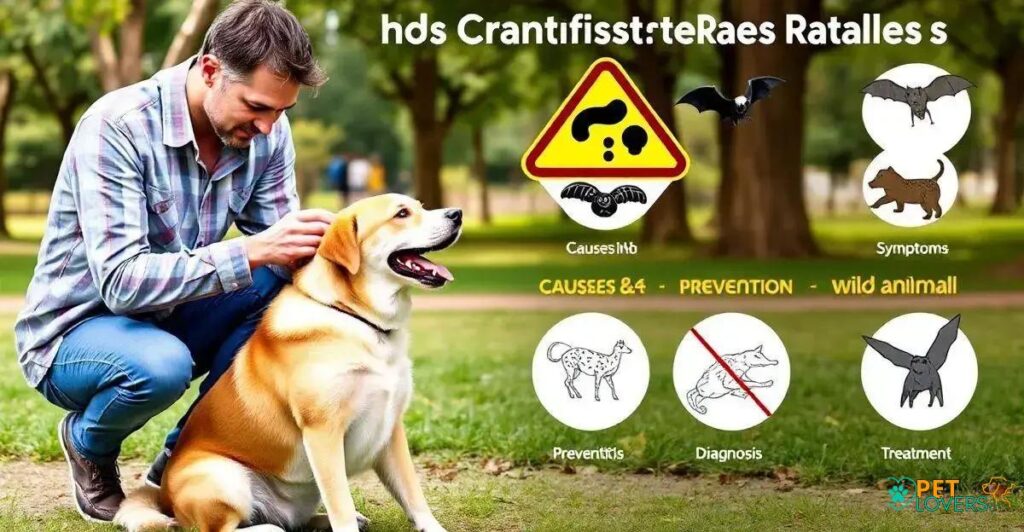Rabies in dogs is a serious viral disease that can be prevented through vaccination and education. It is transmitted via bites from infected animals, leading to symptoms such as behavioral changes, paralysis, and difficulty swallowing. Keeping your dog’s vaccinations current is essential for prevention. If bitten by an infected animal, seek veterinary care immediately.
Rabies, a viral disease that affects the central nervous system of mammals, is a significant threat to dogs worldwide. How dogs contract rabies is a crucial question that every dog owner should know the answer to.
In this article, we will delve into the causes, symptoms, prevention, and treatment of rabies in dogs, providing you with valuable insights to keep your furry friend safe.
Causes and Transmission of Rabies in Dogs
Rabies in dogs is primarily caused by the bite of an infected animal, such as a bat, raccoon, or skunk. The virus is transmitted through the saliva of these animals and is typically spread through a deep bite wound. How dogs contract rabies is a complex process that involves the interaction of several factors, including the type of virus, the location of the bite wound, and the health status of the dog. In this section, we will explore the causes and transmission of rabies in dogs in more detail.
The symptoms of rabies in dogs can vary depending on the stage of the disease and the individual dog. In the early stages, dogs may exhibit changes in behavior, such as aggression, fear, or confusion. As the disease progresses, dogs may develop symptoms such as paralysis, seizures, and difficulty swallowing. In the final stages, dogs may exhibit extreme aggression and may become disoriented and confused. It is essential to recognize the symptoms of rabies in dogs early on to prevent the spread of the disease.
Prevention and control of rabies in dogs involve a combination of vaccination, quarantine, and education. Vaccination is the most effective way to prevent rabies in dogs, and it is recommended that all dogs be vaccinated annually. Quarantine is also an essential measure to prevent the spread of the disease, and dogs that have been bitten by an infected animal should be isolated immediately. Education is also crucial in preventing rabies, as it helps dog owners understand the risks and take necessary precautions to protect their pets.
Diagnosis of rabies in dogs is typically made through a combination of clinical signs, laboratory tests, and post-mortem examination. Clinical signs include changes in behavior, paralysis, and difficulty swallowing. Laboratory tests, such as the fluorescent antibody test, can detect the presence of the virus in the dog’s saliva, brain, or other tissues. Post-mortem examination is also used to confirm the diagnosis of rabies in dogs that have died from the disease.
Conclusion: Protecting Your Dog from Rabies
Symptoms of Rabies in Dogs
Rabies in dogs can cause a wide range of symptoms, which can vary depending on the stage of the disease and the individual dog. In the early stages, dogs may exhibit changes in behavior, such as aggression, fear, or confusion. They may also display unusual behavior, such as
excessive barking, whining, or panting
. As the disease progresses, dogs may develop physical symptoms, including
paralysis of the face, legs, or tail
,
seizures
, and
difficulty swallowing
. In the final stages, dogs may exhibit extreme aggression and
disorientation and confusion
. It is essential to recognize the symptoms of rabies in dogs early on to prevent the spread of the disease.
Prevention and Control of Rabies in Dogs
Preventing and controlling rabies in dogs requires a multi-faceted approach that includes vaccination, quarantine, and education.
Vaccination is the most effective way to prevent rabies, and it is recommended that all dogs be vaccinated annually.
In addition to vaccination, dog owners should also take steps to prevent their pets from coming into contact with wild animals that may carry the virus.
This can include keeping dogs on a leash when walking them, avoiding areas where wild animals are present, and keeping garbage and pet food secure.
If a dog has been bitten by an infected animal, it is essential to seek medical attention immediately and follow the advice of a veterinarian.
By taking these precautions, dog owners can help prevent the spread of rabies and keep their pets safe.
Diagnosis and Treatment of Rabies in Dogs
Diagnosing rabies in dogs typically involves a combination of clinical signs, laboratory tests, and post-mortem examination.
Clinical signs may include changes in behavior, paralysis, and difficulty swallowing.
Laboratory tests, such as the fluorescent antibody test, can detect the presence of the virus in the dog’s saliva, brain, or other tissues.
Post-mortem examination is also used to confirm the diagnosis of rabies in dogs that have died from the disease.
Treatment for rabies in dogs is typically focused on managing the symptoms and preventing the spread of the disease.
This may include providing supportive care, such as fluids and nutrition, and administering antiviral medications.
In severe cases, dogs may require hospitalization and intensive care.
Vaccination is also a crucial part of preventing and controlling rabies in dogs, and it is recommended that all dogs be vaccinated annually.
Conclusion: Protecting Your Dog from Rabies
Rabies in dogs is primarily caused by the bite of an infected animal, such as a bat, raccoon, or skunk. The virus is transmitted through the saliva of these animals and is typically spread through a deep bite wound. How dogs contract rabies is a complex process that involves the interaction of several factors, including the type of virus, the location of the bite wound, and the health status of the dog. In this section, we will explore the causes and transmission of rabies in dogs in more detail.
Rabies in dogs can cause a wide range of symptoms, which can vary depending on the stage of the disease and the individual dog. In the early stages, dogs may exhibit changes in behavior, such as aggression, fear, or confusion. They may also display unusual behavior, such as
excessive barking, whining, or panting
. As the disease progresses, dogs may develop physical symptoms, including
paralysis of the face, legs, or tail
,
seizures
, and
difficulty swallowing
. In the final stages, dogs may exhibit extreme aggression and
disorientation and confusion
. It is essential to recognize the symptoms of rabies in dogs early on to prevent the spread of the disease.
Preventing and controlling rabies in dogs requires a multi-faceted approach that includes vaccination, quarantine, and education. Vaccination is the most effective way to prevent rabies, and it is recommended that all dogs be vaccinated annually. In addition to vaccination, dog owners should also take steps to prevent their pets from coming into contact with wild animals that may carry the virus. This can include keeping dogs on a leash when walking them, avoiding areas where wild animals are present, and keeping garbage and pet food secure. If a dog has been bitten by an infected animal, it is essential to seek medical attention immediately and follow the advice of a veterinarian. By taking these precautions, dog owners can help prevent the spread of rabies and keep their pets safe.
Diagnosing rabies in dogs typically involves a combination of clinical signs, laboratory tests, and post-mortem examination. Clinical signs may include changes in behavior, paralysis, and difficulty swallowing. Laboratory tests, such as the fluorescent antibody test, can detect the presence of the virus in the dog’s saliva, brain, or other tissues. Post-mortem examination is also used to confirm the diagnosis of rabies in dogs that have died from the disease. Treatment for rabies in dogs is typically focused on managing the symptoms and preventing the spread of the disease. This may include providing supportive care, such as fluids and nutrition, and administering antiviral medications. In severe cases, dogs may require hospitalization and intensive care. Vaccination is also a crucial part of preventing and controlling rabies in dogs, and it is recommended that all dogs be vaccinated annually.
Fighting rabies requires a comprehensive approach that includes education, vaccination, and quarantine. By understanding the causes and transmission of rabies, recognizing the symptoms, and taking steps to prevent and control the disease, dog owners can help protect their pets and keep them safe. Remember to always keep your dog’s vaccinations up to date, and seek medical attention immediately if you suspect your dog has been bitten by an infected animal. With the right knowledge and precautions, you can help prevent the spread of rabies and keep your dog healthy and happy.
Protect Your Dog from Rabies
Fighting rabies requires a comprehensive approach that includes education, vaccination, and quarantine.
By understanding the causes and transmission of rabies, recognizing the symptoms, and taking steps to prevent and control the disease, dog owners can help protect their pets and keep them safe.
Remember to always keep your dog’s vaccinations up to date, and seek medical attention immediately if you suspect your dog has been bitten by an infected animal.
With the right knowledge and precautions, you can help prevent the spread of rabies and keep your dog healthy and happy.
FAQ – Frequently Asked Questions about Rabies in Dogs
What are the symptoms of rabies in dogs?
Rabies in dogs can cause a wide range of symptoms, including changes in behavior, paralysis, and difficulty swallowing. In the early stages, dogs may exhibit changes in behavior, such as aggression, fear, or confusion.
How is rabies transmitted in dogs?
Rabies is primarily transmitted through the bite of an infected animal, such as a bat, raccoon, or skunk.
Can rabies be prevented in dogs?
Yes, rabies can be prevented in dogs through vaccination and education. Keeping your dog’s vaccinations up to date and taking steps to prevent contact with wild animals that may carry the virus can help prevent the spread of rabies.
What should I do if my dog is bitten by an infected animal?
If your dog is bitten by an infected animal, seek medical attention immediately and follow the advice of a veterinarian.
Can rabies be treated in dogs?
Treatment for rabies in dogs typically involves managing the symptoms and preventing the spread of the disease. This may include providing supportive care, such as fluids and nutrition, and administering antiviral medications.
How can I protect my dog from rabies?
You can protect your dog from rabies by keeping their vaccinations up to date, taking steps to prevent contact with wild animals that may carry the virus, and seeking medical attention immediately if you suspect your dog has been bitten by an infected animal.

